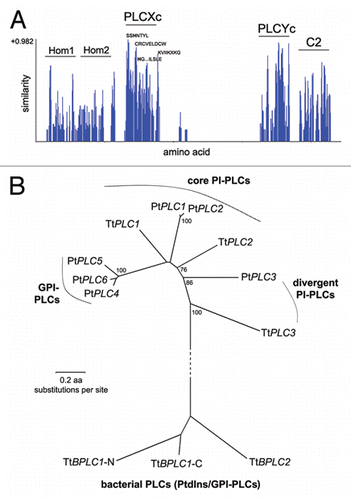Figures & data
Figure 1 Ciliate PI-PLC genes. (A) Similarity graph of the consensus obtained after multiple sequence alignment of full length TtPLC1–3 and PtPLC1–6. Regions of significant similarity correspond primarily to PLCXc, PLCYc and C2 domains. Key features in the PLCXc domain are indicated as well (see Sup. Fig. 2C in ref. Citation4 for a detailed description). The gap between PLCXc and PLCYc domains is due to the large TtPLC3/PRIP X–Y linker. Hom 1 (homology 1) region corresponds to the predicted PH domain of TtPLC3/PRIP (reviewed in ref. Citation4). Interestingly, the respective region in PtPLC2 (31–136 aa) is retrieved as a putative PH domain in SMART database and blastp searches against all Tetrahymena and Paramecium genes using this PtPLC2 region recovers PtPLC1 (e-value = e−57), TtPLC1–2 (e-value= e−6 − e−9) and TtPLC3/PRIP (e-value = e−3) as the best scoring hits. The Hom 2 (homology 2) region roughly corresponds to the predicted EF hand motifs in TtPLC1–3 and PtPLC1–2 (reviewed in ref. Citation4 and Citation6, respectively). (B) The indicated evolutionary relationships were inferred from alignments of the PLCXc domain using the Neighbor-Joining method while the evolutionary distances were computed using the Poisson correction method (MEGA 4.0 software, as in ref. Citation4). PtPLC1 and 2 and PtPLC4 and 6 are pairs of paralogous genes from the last whole genome duplication in P. tetraurelia (reviewed in ref. Citation6), while TtPLC3/PRIP is the most divergent ciliate PLC. Tetrahymena BPLC1 and BPLC2 PLCXc domains were positioned as an outgroup to the rest PLCs. Bootstrap values from 1,000 replicates (higher than 75%) are indicated near corresponding branches. Gene locus tags for ciliate PLCs are: TtPLC1, TTHERM_00486470; TtPLC2, TTHERM_00238850; TtPLC3/PRIP, TTHERM_00085110; PtPLC1, (PLC3 in ref. Citation6), GSPATT00031253001; PtPLC2 (PLC5 in ref. Citation6), GSPATT00029973001; PtPLC3 (PLC1 in ref. Citation6), GSPATT00008002001; PtPLC4, GSPATT00031342001; PtPLC5 (PLC2 in ref. Citation6) GSPATT00034681001; PtPLC6, GSPATT00030070001; TtBPLC1, TTHERM_00426140; TtBPLC2, TTHERM_00348190.
